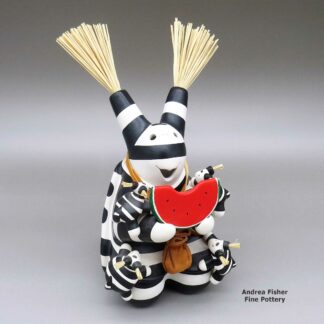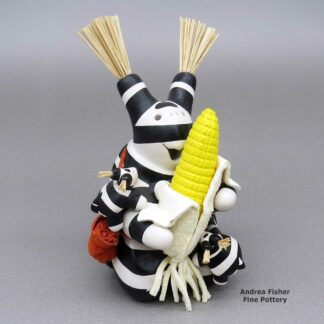Koshare
About Koshares, the Sacred Clowns
Among the religious figures in Pueblo societies is an order of "sacred clowns," also known as Chiffoneti. Among the Hopi they are a group of five distinct figures known collectively as Payakyamu. They are also known as Kossa in the Tewa language, Koshare in the Keres language, Tabosh among the Jemez and Newekwe among the Zunis.
The terms are a bit generic as each pueblo has its own unique names. Those names also vary according to the kiva (confraternity or secret society) they belong to. Each has a unique role in the community year-round, like invoking rainfall. They also perform in the annual spring and summer fertility rites.
Among the Hopi there are 5 clown figures. Four of them are katsinam (personifications of spirit). The fifth is the Koshare, a figure that came to Hopi country with the Tewas who migrated there in the years after the 1680 Pueblo Revolt. When a Hopi dancer dons the mask of a katsina it is believed that the dancer's personality abandons the body and that spirit possesses it.
The Koshare clan seems to have sprung into existence about the same time as the great migrations out of the Four Corners and Mesa Verde areas in the latter part of the 1200s CE. By the 1400s, there were members of the Sacred Clown Society in virtually every pueblo in the Southwest.
Among the other Pueblo peoples, the sacred clowns don't wear masks. Instead, they present themselves with black and white horizontal stripes painted on their faces and bodies, paint black circles around their eyes and mouths, and part their hair down the middle, bind it in two bunches which stand upright on either side of their head and trim those bunches with corn husks. They are also often portrayed with slices of watermelon in hand or near at hand, personifications of "Don't worry, be happy!"
Their function is to help defuse community tensions by offering their own humorous take on their tribe's popular culture, by communicating tribal traditions and by reinforcing tribal taboos.
European courts often used to have a "jester" who offered similarly meaningful and humorous social commentary on activities in the court and the kingdom. Juan Suni was a Hopi Koshare who performed his duties one day in 1656 by humorously impersonating the resident Franciscan priest at Awatovi. He continued living his life as a Koshare as he journeyed from Hopi country to Santa Fe. In Santa Fe, in 1659, he was arrested and put on trial. The Spanish recounted a number of "offenses" Juan had performed on his journey to Santa Fe and they sentenced him to 20 years of slavery for his actions.
40 years later, the Hopis destroyed Awatovi, burning the pueblo, tearing down the walls and killing almost all the residents. Awatovi at the time was the largest pueblo in Hopi country (although most residents seem to have spoken either Towa or Keres). Awatovi was also the site of the only Spanish mission in all of Hopiland.
Showing all 2 results
-

Randall Chitto, jhmm3b160, Turtle koshare storyteller
$495.00 Add to cart -

Randall Chitto, jhmm3b161, Turtle koshare storyteller
$195.00 Add to cart
Showing all 2 results